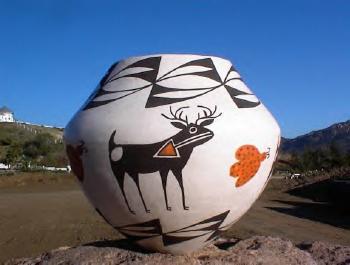|
 Pottery
has documented the lives and cultures of people all over the world for thousands of years. While clay bowls and
other vessels served a practical purpose, the craftsmen who made them recorded events and expressed ideas by decorating
the surfaces with designs, symbols and drawings called pictographs. Archaeologists can learn a great deal about
ancient peoples by studying their pottery and these designs. Pottery
has documented the lives and cultures of people all over the world for thousands of years. While clay bowls and
other vessels served a practical purpose, the craftsmen who made them recorded events and expressed ideas by decorating
the surfaces with designs, symbols and drawings called pictographs. Archaeologists can learn a great deal about
ancient peoples by studying their pottery and these designs.
There is evidence that Native Americans were making pottery in southern New England about 3,000 years ago. With
the arrival of Europeans in 1620, Native-made ceramic vessels were replaced by containers made of glass, metal,
and ceramic from the Old World. However, Native Americans continued to use their designs on other items such as
metal work and textiles.
You may not have clay or a kiln in which to bake finished pieces, but we can make something that looks like pottery
using the papier mache technique, a craft in which layers of paper are pasted together to make a form. In this
activity, we'll create a bowl and invent our own pictographs to use as surface decoration. By recycling newspapers
and bags as art materials, we can help save natural resources and landfill space.
 You Will Need: You Will Need:
- Wallpaper paste
- Black or brown acrylic paint
- Wax paper
- Plastic wrap
- Masking tape
- Newspapers
- Lightweight, brown paper bag
- Small glass or ceramic bowl
- Plastic container for paste
- Paint brushes and pan
 How
to: How
to:
Protect the table with newspapers, and work on a sheet of wax paper. Cover the outside and rim of the bowl with
plastic wrap. Smooth it, pull the wrap tight, and tape it to the inside of the bowl. Place the bowl upside down
on the wax paper. Mix the wallpaper paste according to the manufacturer's directions.
The brown bag is the first layer of paper applied to the bowl. To help soften the bag, tightly roll the paper into
a ball. Smooth it out, and tear it into small squares or rectangles. Dip a paper strip into the mixture, and remove
the extra paste by running the strip between your fingers and thumb.
Starting at the bottom or rim, lay the strip onto the bowl and smooth it. Repeat with another strip, being careful
to slightly overlap the first one. Continue pasting the paper in this way all around the rim of the bowl. When
you've finished, cover the rest of the bowl with strips of brown paper.
Now apply a layer of black and white newsprint starting at the rim, as before. Next paste a layer of the colored
comics to the bowl. Continue alternating between the newsprint and the comics until you've pasted at least four
layers of each to the form. Using the two kinds of newspaper will help you keep track of the number of layers you've
added.
Finish the papier mache by applying another layer of brown paper. Allow the bowl to dry for at least twelve hours.
Remove the bowl from the papier mache form, and finish the rim by pasting brown paper all around the edge. When
the bowl is completely dry, you're ready to paint it.
You can invent your own pictographs to use in decorating your bowl. Make symbols or designs to represent important
ideas or to record events in your life. Use pictographs to express who you are, where you live, and what you like
to do. After you've created a few symbols, draw them on the outside and/or inside of the bowl. Use acrylic paint
to fill in the outline. When you've finished painting, set the bowl aside to dry.
 Tips and Tricks: Tips and Tricks:
When working with papier mache, it's better to tear the strips of paper, because torn strips lay better than cut
ones. Also, the fibers in newspaper run in one direction, so tear the paper along the "grain" to obtain
long strips. If you'd like to make a heavier bowl, just add five to ten more layers of papier mache to the form.
While the bowl is strictly decorative, you can help protect it with a coat of acrylic varnish.
Can you imagine painting without a brush? People living in ancient times had to make their own brushes and tools
to apply paint. Challenge yourself to decorate your bowl without using modern art tools. Try creating your own
brushes, or sharpen a twig, dip it into paint, and make marks on the surface of your bowl.
The aborigines of Australia have been painting beautiful dot designs with sticks for thousands of years! You can
try your hand at stick painting by using short lengths of dowel rods, cotton swabs, or similar materials. Dip the
stick into paint, and apply it to the bowl. Repeat until this area is covered with a design.
from crafts for kids at About.com
|